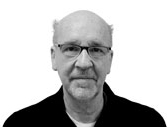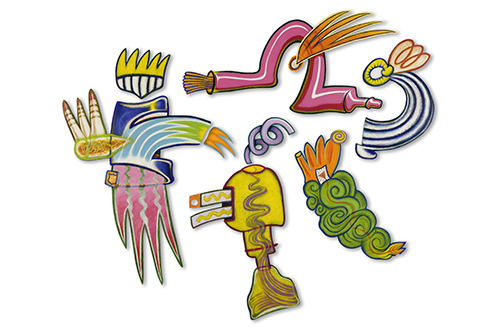
PAUL KRAINAK
William talks about the complexity of the job that he loves.
“Most people assume all I do is curate art and hire bands, but it’s a small part of my daily activity,” he said.
He spends 50-60 hours per week handling correspondence, promotion, maintaining email and membership data bases, planning regular and special events like art education programs, organizing volunteers, etc. With the owners of the building, he helps to oversee general building maintenance and projects for the entire facility. He manages volunteers and one part-time employee.

Animated Consul, acrylic on 8 shaped boards, 70 x 84 inches, 2017 (PHOTO BY DON ROSSER)
William was also influenced by early modernists such as Joan Miro and most interestingly the paintings of Le Corbusier. I can count on one hand the number of painters I’ve met who acknowledge Corbusier, a fountainhead of modern architecture, as a source of inspiration for painting. But “Corbu” is an apropos figure partly because he fully engaged two-dimensional art mediums and collaborated with Amedee Ozenfant in their conception of Purism. The idea was a reformed Cubism and their compositions were more well-behaved, flatter and formal. William was drawn to Corbu’s focus on structure and experimentalism that spoke to his more deliberative side. William then augmented the Purist surface texture and juxtaposed other art languages with a penchant for Surrealism. This led him circuitously to Elizabeth Murray, whose richly corrosive color pallet and contours were whimsical and as sculptural as they were painterly. William’s images became more abstract, but quizzical, and exceedingly funky as he employed more free association and gesturalism.
William exploited the kitschified air that distinguished many ‘70s Midwestern and Californian regionalist painters, printmakers and illustrators. He absorbed imagery that remind some of the Neo-Pop artist Peter Saul whose quivering, acidic images influenced a decade of young High Fructose Magazine illustrators. William’s references to body parts, flower blooms, syringe-shapes, cox-comb details and bric-a-brac mimic lost board game pieces and picture puzzle fragments and are saturated with absurdity. For William they emerge, spontaneously and dreamlike from an imaginary laboratory experiment gone off the rails. Their vague cautionary tales still maintain dark outlined images from comic book illustration and they deflect theoretical analysis with humor and cyclone debris.
The connections to printmaking iconography, comic books and the experimentalism of the original avant-garde are remnants of modernism’s critique of classicism and mainstream culture. William’s work is fun, sure, but it’s also antagonistic to more sober art forms and today’s sanctioned globalist styles. He has a quirky, but verifiable, connection to folk art and neo-primitivism that gripped European modernists as they rebelled against the academy in the early stages of modernism. Decades later, post-war anti-formalists in the States recalled the Surrealists and Expressionists and depicted alternatives to academicism, resisting progressivist kinds of orthodoxy. William Butler contributes skillfully and cheerfully to the still independent, vibrant, introspective pictorialism that continues to resonate for many Midwest artists.

5 comments for “Inland Art | Finding time to create art”
Recent Comments
Wow! Fantastic job, Paul. Thanks again for choosing to write this article about me and the work. You could have chosen to write about any hundreds of artists; I am very honored. This is the first major critical analysis of my art. I am challenged to reexamine it through your lens.
-William Butler
Excellent article that adds an in depth description from a knowledgeable viewer’s point of perception. Your observations gives William constructive feedback and followers of his work an enriched collective experience and appreciation. Congratulations William! Well done and thank you Paul.
Michael Hagenbuch
Thank you for your kind comments Michael. It was my pleasure.
Thanks Michael. Your support means so much!!!
Thank you William. I enjoyed digging deeper into your work.